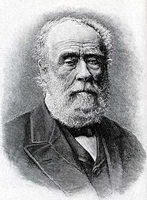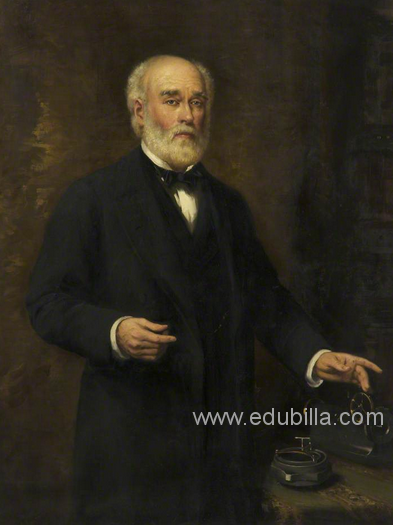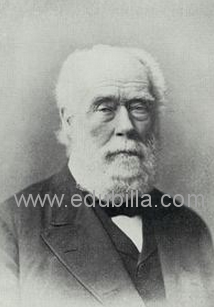










Sir Joseph Whitworth, 1st Baronet (21 December 1803 – 22 January 1887) was an English engineer, entrepreneur, inventor and philanthropist.[1] In 1841, he devised the British Standard Whitworth system, which created an accepted standard for screw threads. Whitworth also created the Whitworth rifle, often called the 'sharpshooter' because of its accuracy and considered one of the earliest examples of a sniper rifle.
At his death in 1887, he bequeathed much of his fortune for the people of Manchester, with the Whitworth Art Gallery and Christie Hospital partly funded by Whitworth's money. Whitworth Street and Whitworth Hall in Manchester are named in his honour. Whitworth was created a baronet on 7 October 1869.
Early life
Whitworth was born in Stockport, Cheshire, the son of Charles Whitworth, a teacher and Congregational minister, and at an early age developed an interest in machinery. He was educated at Idle, near Bradford, West Riding of Yorkshire; his aptitude for mechanics became apparent when he began work for his uncle.
After leaving school Whitworth became an indentured apprentice to his uncle, Joseph Hulse, a cotton spinner at Amber Mill, Oakerthorpe in Derbyshire. The plan was that Whitworth would become a partner in the business. From the outset he was fascinated by the mill's machinery and soon he mastered the techniques of the cotton spinning industry but even at this age he noticed the poor standards of accuracy and was critical of the milling machinery. This early exposure to the mechanics of the industry forged in him the ambition to make machinery with much greater precision. His apprenticeship at Amber Mill lasted for a four year term after which he worked for another four years as a mechanic in a factory in Manchester. He then moved to London where he found employment working for Henry Maudslay, the inventor of the screw-cutting lathe, alongside such people as James Nasmyth (inventor of the steam hammer) and Richard Roberts.
Whitworth developed great skill as a mechanic while working for Maudslay, developing various precision machine tools and also introducing a box casting scheme for the iron frames of machine tools that simultaneously increased their rigidity and reduced their weight.
Whitworth also worked for Holtzapffel & Co (makers of ornamental lathes) and Joseph Clement. While at Clement's workshop he helped with the manufacture of Charles Babbage's calculating machine, the Difference engine. He returned to Openshaw, Manchester, in 1833 to start his own business manufacturing lathes and other machine tools, which became renowned for their high standard of workmanship. Whitworth is attributed with the introduction of the thou in 1844.In 1853, along with his lifelong friend, artist and art educator George Wallis (1811–1891), he was appointed a British commissioner for the New York International Exhibition. They toured around industrial sites of several American states, and the result of their journey was a report 'The Industry of the United States in Machinery, Manufactures and Useful and Applied Arts, compiled from the Official Reports of Messrs Whitworth and Wallis, London, 1854.'
In 1850, architect Edward Walters was commissioned to build 'The Firs' for Whitworth. This was a grand mansion at Fallowfield, Manchester, which still stands today, functioning as Chancellors Hotel & Conference Centre.
Whitworth received many awards for the excellence of his designs and was financially very successful. In 1850, then a Fellow of the Royal Society and President of the Institution of Mechanical Engineers, he built a house called 'The Firs' in Fallowfield, south Manchester. In 1854 he bought Stancliffe Hall in Darley Dale, Derbyshire and moved there with his second wife Louisa in 1872. He supplied four six-ton blocks of stone from Darley Dale quarry, for the lions of St. George's Hall in Liverpool. He was conferred with Honorary Membership of the Institution of Engineers and Shipbuilders in Scotland in 1859.
A strong believer in the value of technical education, Whitworth backed the new Mechanics' Institute in Manchester (later UMIST) and helped found the Manchester School of Design. In 1868, he founded the Whitworth Scholarship for the advancement of mechanical engineering. He donated a sum of £128,000 to the government in 1868 (approximately £6.5 million in 2010) to bring "science and industry" closer together and to fund scholarships.
Death
In January 1887 at the age of 83, Sir Joseph Whitworth died in Monte Carlo where he had travelled in the hope of improving his health. He was buried at St Helen's Church, Darley Dale, Derbyshire. A detailed obituary was published in the American magazine The Manufacturer and Builder (Volume 19, Issue 6, June 1887). He directed his trustees to spend his fortune on philanthropic projects, which they still do to this day. Part of his bequest was used to establish the Whitworth Art Gallery, now part of the University of Manchester.

